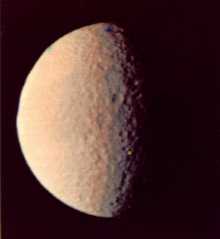This is an image of Tethys.
Click on image for full size
NASA/JPL
Tethys
Tethys was discovered by G. Cassini in 1684. Tethys is the 8th closest moon to Saturn, with a standoff distance of 294,660 km. It is one of the
icy moons, similar to the
Galilean satellites. Tethys is about as wide as the length of the Oregon coast, a width of 1050 km (700 miles).
Tethys is has a rather heavily cratered surface, with deep trenches. In appearance, this moon looks very much like Dione, Enceladus, and Rhea.
You might also be interested in:

The Galilean satellites are the 4 major moons of Jupiter, Io, Europa, Ganymede, and Callisto. In this picture, Io, and Io’s surface, are shown on the left-most end, then Europa, and its surface, then Ganymede,
...more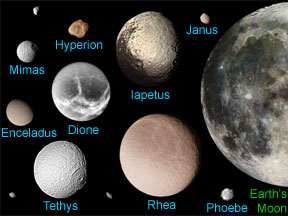
Saturn has // Call the moon count function defined in the document head print_moon_count('saturn'); moons. Many of those are tiny chunks of rock or ice only a few kilometers (miles) across. One of Saturn's
...more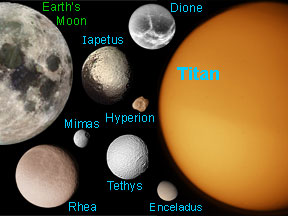
Saturn has // Call the moon count function defined in the document head print_moon_count('saturn'); moons. Many of those are tiny chunks of rock or ice only a few kilometers (miles) across. One of Saturn's
...more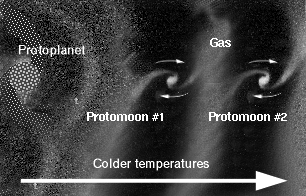
Titan is similar to the other icy moons, but Titan is the only icy moon to have a big atmosphere. It is natural to ask how is this possible? The nebula was colder near Saturn, than near Jupiter. The nebula
...more
Titan's atmosphere is a lot like the Earth's, except that it is very cold, from -330 degrees to -290 degrees! Like the Earth, there is a lot of Nitrogen and other complex molecules. There also may be an
...more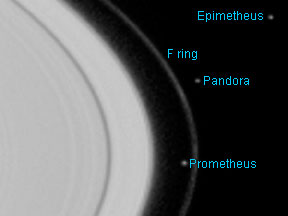
Pandora is a small moon of Saturn. It was discovered by S. Collins and others in 1980 from photos taken by the Voyager 1 spacecraft. Pandora's name comes from Greek mythology. Pandora was the first woman,
...more
Prometheus is a small moon of Saturn. It was discovered by S. Collins and others in 1980 from photos taken by the Voyager 1 spacecraft. This moon's name comes from Greek mythology. Prometheus was a Titan
...more


